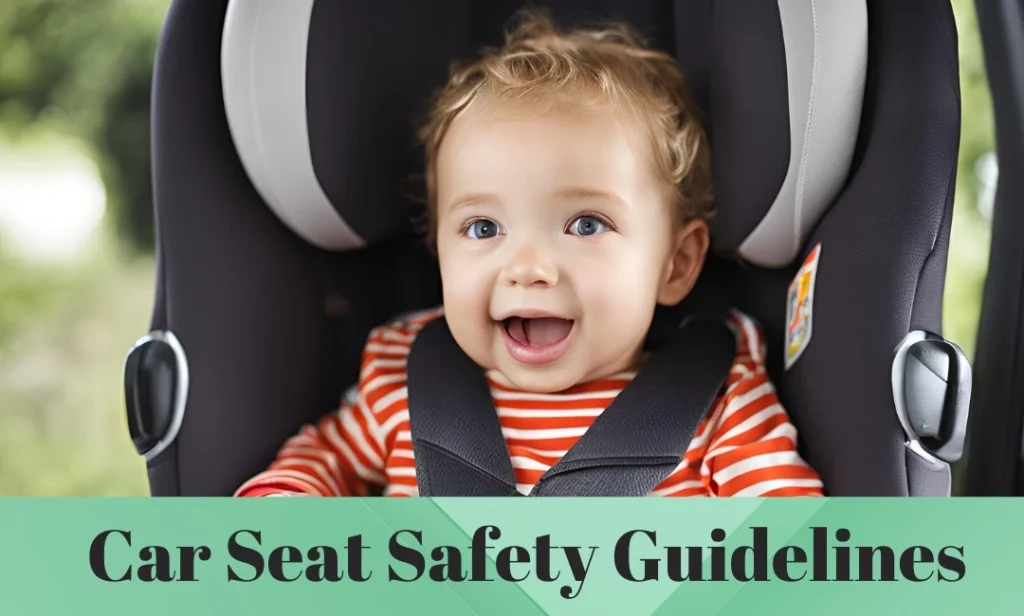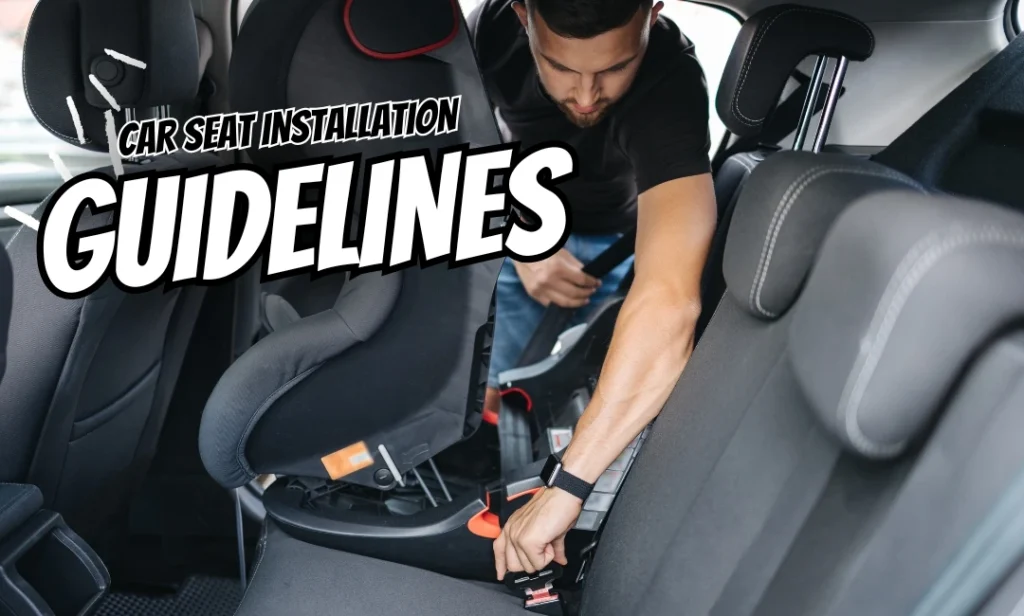After all the anxiety of driving home after giving birth and carpooling to school, soccer practice and sports, every parent’s primary concern is making sure their child is transported safely in the car; one of these is the proper use of the appropriate car seat for that child.
In Texas, it is mandatory to sit in proper child safety seats for children under the age of 8, or until they reach 4 feet 9 inches in height, whether rear-facing or forward-facing or a booster seat. After that, the child must wear a seat belt if they are taller than the booster. Texas car seat laws aren’t just what every parent should know – they’re also laws that protect your child in the event of an accident or finding yourself on the other side of the law.
So, let’s take a look at this quick guide on Texas car seat laws before you tell the world. The more you know, the better you’ll be able to keep your family safe every time you get in the car.
Texas Car Seat Laws Explained
Child car seat laws in Texas aim to give kids proper road safety. If your kid is under the age of eight and not taller than 4 feet 9 inches, then they must be put in a child safety seat. The kind of seat depends upon the child’s age, height, and weight. Infant and toddler seats should be in a rear-facing car seat position, until at least the age of 2. From here, they can move to the forward-facing car seat until approximately age 5. The next step is using a booster seat until the child is big enough for a seat belt, occurring at around age eight or when they reach a height of 4 feet 9 inches.
At that point, they must sit with a seat belt all the time they are in the vehicle. According to Texas car seat laws, failure to comply can lead to a $250 fine, and also not using seat belts can put your child at risk.
Always ensure that car seats are installed correctly and meet the manufacturer’s guidelines in all cases to avoid accidents and injuries. An adequately secured car seat can be the final deciding factor to protect your kid in the event of a crash.
Booster Car Seat Laws in Texas

When your child outgrows the forward-facing car seat, then the next step for your child’s safety is using booster seats. Booster seats lift your child so the seat belt fits correctly: the shoulder strap rests across your child’s chest (and nowhere near his neck or face); the lap belt fits snugly across the thighs, rather than a stomach. It can reduce the chances of injuries and accidents.
So, once children exceed a weight of 40 pounds and are below the height of 4 feet 9 inches, they get buckled up in a booster seat. This typically occurs between ages 8 and 12. Boosters must always be used with both lap and shoulder belts, NEVER just with a lap belt.
There are two types of booster seats: high-back and backless. A high-back booster is best if your vehicle doesn’t have a headrest or tall seat back for additional support.
Do not rush to get rid of the booster once your child achieves the legal height. You should ensure that your child can sit back against the car seat with both knees bent over the edge and the seat belt snug across the chest and upper thighs. If that seatbelt does not fit right, your child is still at risk of not being appropriately protected in the event of a crash. These guidelines keep your little one safely overlapped whenever they are in a vehicle.
The Crucial Role of Car Seats in Child Safety
Every year, more children are severely injured or killed in vehicular accidents than can be counted. Proper use of car seats and booster seats may reduce the number of accidents. When installed and used correctly, child safety seats do a lot to protect children and help reduce the likelihood of injury in an automobile crash.
Research by the Centers for Disease Control shows the risk of injury is 71%-82% lower when a child is placed in a car seat rather than buckled up. For older children, booster seats decrease the likelihood of a significant injury by 50%.
In Texas and most other states, the law mandates that children below a certain age or height be restrained in an infant car seat or booster seat. This is not merely a matter of keeping within the dictates of the law but, more fundamentally, to ensure children receive the best possible protection afforded while traveling by car. Taking these simple precautions can go a long way in keeping your precious little ones safe on the road.
Car Seat Safety Guidelines Every Parent Should Follow

To ensure your child is properly secured in the car throughout the riding duration, the selection of the correct car seat is of uttermost importance. Check out our simple overview of age- and size-based car seat safety guidelines:
- Baby up to 2 years: Children should ride in a rear-facing car seat until at least 2 years of age or they outgrow the height or weight limit criteria designated by the manufacturer.
- 2 years and older: Once a child outgrows the rear-facing stage, he or she should be transferred to a forward-facing seat with an internal harness. This harness should accommodate children until their height or weight surpasses the manufacturer’s limits. If a child reaches age 2 and exceeds the specifications of the rear-facing seat prior to that age, they may also transition into a forward-facing seat.
- 4 to 8 years: The next step is to switch to a booster seat after outgrowing the forward-facing stage. Children should remain in a booster until they reach at least 49 inches, under which a tremendous number will make the switch in between the ages of 8 and 12. The booster position should help facilitate the proper fit of the seatbelt.
Do read the label on your car seat for specific height and weight requirements, as they vary between manufacturers. Following these guidelines will enable you to keep your child protected and secure whenever you take to the wheel.
Fines & Penalties for Ignoring Texas Car Seat Laws
If you don’t follow Texas car seat and booster seat laws, you could face some hefty fines. A first offense could cost as much as $250 in addition to court costs. On the second offense, the penalties may increase further, and your driver’s license could get points added to it, too.
But that isn’t the only loss. A violation record would definitely raise your insurance rates down the line.
Most importantly, though, the real danger comes from compromising your child’s safety. Those laws aren’t just about avoiding getting tickets — they are set in place to keep kids from serious injuries or worse in a crash. Following the car seat laws is not just about “going easy” on the ticket system; it safeguards your young child while in motion on the roads.
Don’t Guess! Here’s How to Choose the Right Car Seat

Whether you own a family-friendly SUV or a luxury sports car, choosing the appropriate car seat for your child is an important decision that requires careful thought. Although Texas child car seat laws provide a useful starting point, other considerations should be made before buying. Here’s a simple guide to help you out in choosing the right car seat:
- Weight, Age, and Height Compatibility: Start by ensuring that the car seat matches your child’s weight, age, and height. The product labeling gives key tips.
- Simplicity of Installation: A complicated installation will result in the likelihood of mistakes in how the car seat is safely secured. Choose models that are simple to install and have precise instructions.
- Five-Point Harness System: This safety feature comprises two shoulder straps, two waist straps, and one strap between the legs, ensuring maximum protection during an accident.
- Side-Impact Safety Features: Some seats have additional safety features like energy-absorbing foam or side-reinforced structures that can safeguard your child in the event of a side impact.
- Comfort Consideration: A cushioned and comfortable seat goes a long way in making your child happy while traveling, leading to happier journeys in general.
- Crash Test Confirmation & Certification: Any vehicle seat must meet the federal safety regulations; focus on products where safety is guaranteed beyond doubt.
- Expiration Knowledge: For the most part, car seats have an expiration date of around six years from when they were made because materials wear down over time; always inspect this prior to buying—particularly when looking into secondhand items.
It’s important to add that more expense doesn’t automatically mean better protection; many cost-effective options do just as good a job as their costly brethren.
Also, it’s best to get your new car seat registered with its maker so that you’ll receive notice if any safety recalls impact your model. Your child’s health remains a top priority, and the choice of the correct car seat is an important one on each ride.
Car Seat Installation Guidelines

According to the National highway traffic safety administration (NHTSA), around 46% of car seats aren’t installed correctly. The law in Texas requires a car seat, and the law says how to properly install them and restrain your child so they’re safe. To be sure that your child receives the maximum possible protection, the setup must be done according to appropriate guidelines.
- Read the manual: there’s no getting around it. Just read the manual properly to understand how it works and follow instructions on its installation.
- Pick the right position: You must always install the car seat in the back seat, and if possible, the safest place is in the middle.
- Check the angle: Check the level indicators on the car seat to ensure everything is at the correct angle. Most rear-facing seats should recline at a 45-degree angle for proper support.
- Secure the seat: The car seat should be properly secured using either the seat belt or LATCH system (lower anchors and tethers for children). Be sure that the straps are in the proper slots and pulled tight.
- Do the wiggle test: After installation, the car seat should not move by more than 1 inch in any direction when tugged at the belt path. If it shifts too much-it needs to be tightened.
Relevant FAQs For Texas Child Car Seat Laws
What Is the Texas Car Seat Law in 2025?
As of 2025, the Texas car seat legislation mandates every child below 8 years old to sit in a booster or child safety seat if they are not 4’9″ tall and above. Babies and young toddlers should use rear-facing car seats up until their 2nd year birthday or the moment they cross the height/weight capacity limit.
Later, they need to switch to a forward-facing car seat with a harness until it’s time to switch again. Children 4 to 8 years of age need to ride in a booster seat until they are able to fit a seat belt correctly. The lap belt must cross low over the hips, and the shoulder belt must cross the chest and shoulder. Not complying with these laws can result in fines of up to $250.
Is a Car Seat Required for a 5-Year-Old in Texas?
Yes, Texas law dictates that any child under the age of 8 must be restrained in a child safety seat unless he or she is taller than 4 ‘9″. For this reason, a car seat is needed for almost any 5-year-old child for safe travel. Correct restraint helps to prevent serious injury and keeps children safe when stuck in a car.
In conclusion, learning the car seat laws in Texas is more than simply remembering how to avoid fines; it’s also about keeping your child safe while traveling. Select the right seat, upgrade it when it’s necessary, and make sure it is installed properly. Therefore, before hitting the road, review your installation and travel with a stress-free mind. After all, safety always comes first.


